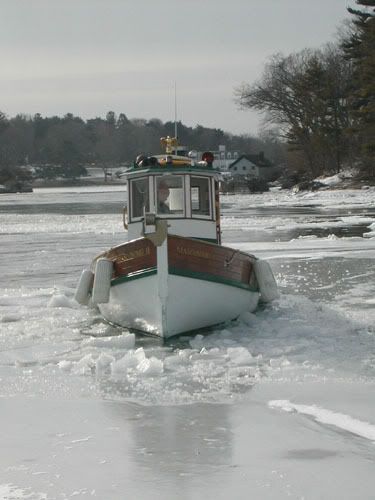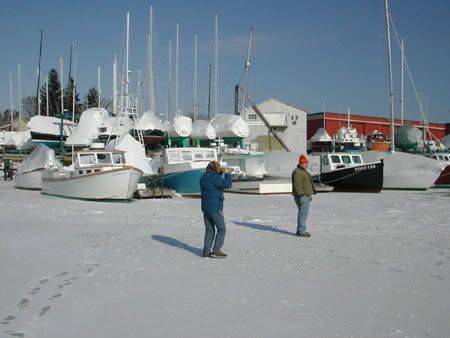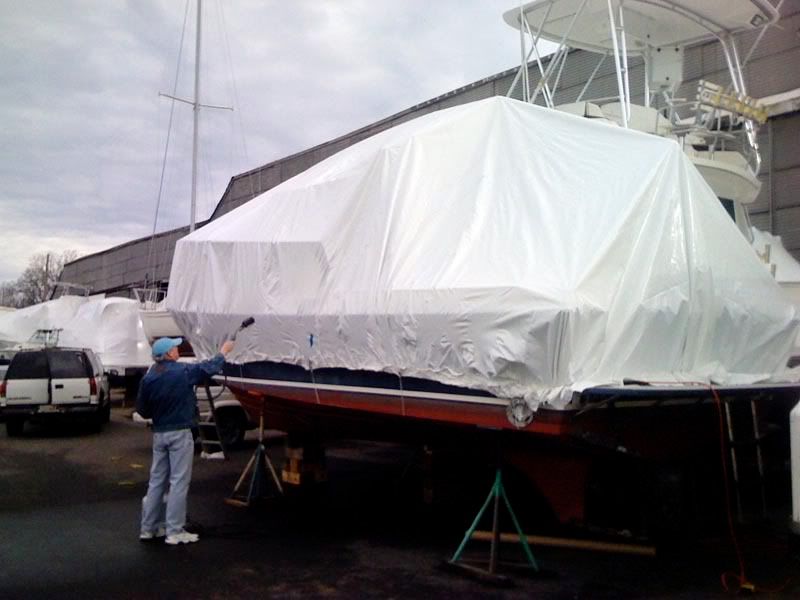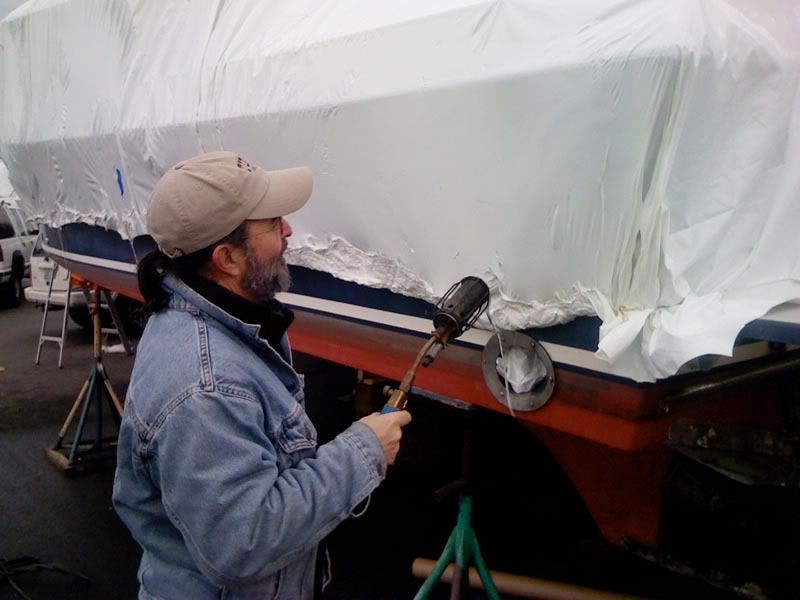• Welcome to https://albinowners.net, home of Albin Owners Group!
• If you don't remember your password, use the I forgot my password link to reset it.
• Contact Us if you have any questions. If you're not receiving our email, include a phone number where we can text you.
• If you don't remember your password, use the I forgot my password link to reset it.
• Contact Us if you have any questions. If you're not receiving our email, include a phone number where we can text you.
FAQ:
• Membership information
• Burgees
• How to post photos
• Membership information
• Burgees
• How to post photos
Shrink wrap and Awlgrip
Moderator: Jeremyvmd
- Cape Codder
- Gold Member

- Posts: 363
- Joined: Thu Apr 19, 2007 8:59 pm
- Location: Falmouth, MA - Cape Cod
Capt. Ron,
That's a great idea of just doing the cockpit area from the arch down. but make sure the fuel fill area was covered.
There are 2 types of white tape. One type is for where you are just taping the shrink wrap, such as putting on a zippered door. The other type is for actually touching the hull which is supposed to come off cleanly. Althuough I have never used the later type, they always ask if that's what I want when I order. The supply house I use has both in 2" and 4" rolls.
That gigantic piece of shrink wrap I used cost about $100. Just covering the cockpit would run around $20. The 4 vents I used can be reused, and so can the zippered door.
Got to ask my buddy , Phil, the shrink wrap expert, what are his thoughts.
He doesn't make any money doing mine....just a free dinner!!
That's a great idea of just doing the cockpit area from the arch down. but make sure the fuel fill area was covered.
There are 2 types of white tape. One type is for where you are just taping the shrink wrap, such as putting on a zippered door. The other type is for actually touching the hull which is supposed to come off cleanly. Althuough I have never used the later type, they always ask if that's what I want when I order. The supply house I use has both in 2" and 4" rolls.
That gigantic piece of shrink wrap I used cost about $100. Just covering the cockpit would run around $20. The 4 vents I used can be reused, and so can the zippered door.
Got to ask my buddy , Phil, the shrink wrap expert, what are his thoughts.
He doesn't make any money doing mine....just a free dinner!!
Bob
2003 Albin 28 TE
Santosha
2003 Albin 28 TE
Santosha
- Pitou
- Gold Member

- Posts: 2091
- Joined: Thu Feb 22, 2007 1:34 pm
- Boat Make/Model (or None): 31TE / Single
- Home Port: Gloucester, MA
- Location: Essex, MA
2 types of tape / Heat Shrink Tape .... sticky stuff / used for attaching doors, hole patrol after heat shrinking and taping seams on pleats. The other is Preservation Tape .... which does not leave adhesive behnd / used for temporarily holding the monster sheet to the hull before shrinking and covering the fuel vents to be removed after the job is done by cutting a hole in the final wrap job / removing the Preservation Tape then taping the hole with the permenant Heat Shrink Tape.
I got into doing this myself the 1st year with the Albin when I still owned 2 boats and was looking at $ 800 for the 2 boats. I decided to buy the gear and had it amortized out the 1st season / I must say I've gotten quite good . As CC says recycle the door for a few seasons and you have easy access for winter projects while you spin up a hot drink in the microwave / maybe a "committee boat tea".
. As CC says recycle the door for a few seasons and you have easy access for winter projects while you spin up a hot drink in the microwave / maybe a "committee boat tea".
I got into doing this myself the 1st year with the Albin when I still owned 2 boats and was looking at $ 800 for the 2 boats. I decided to buy the gear and had it amortized out the 1st season / I must say I've gotten quite good
kevinS
>><<>>;>
Former Boats:
- 2006 31TE / Hull# 221
Cummins QSC 8.3 / 500 hp
December '13 - April '23
- 2002 / 28TE / Hull# 614
Cummins 6BTA 370 hp / Alaskan Bulkhead
April '04 ~ May '13
>><<>>;>
Former Boats:
- 2006 31TE / Hull# 221
Cummins QSC 8.3 / 500 hp
December '13 - April '23
- 2002 / 28TE / Hull# 614
Cummins 6BTA 370 hp / Alaskan Bulkhead
April '04 ~ May '13
- Mariner
- Gold Member

- Posts: 1455
- Joined: Mon Apr 17, 2006 11:18 am
- Location: Gig Harbor, WA
- Pitou
- Gold Member

- Posts: 2091
- Joined: Thu Feb 22, 2007 1:34 pm
- Boat Make/Model (or None): 31TE / Single
- Home Port: Gloucester, MA
- Location: Essex, MA
For the most part docks are hauled as the inlets and rivers freeze solid and the ice heaves with the coming and going of the rise and fall of the tide. This prevents major damage to floats and boats. Hence many of us are on the hard. The idea of covering is to protect the boat from the same things that go on in the river. The weather conditions are often such on the east coast that a storm can start as snow for 2-3, 6" or a foot or more and change to rain on the tail end as it did this past Monday and then the temps drop to below freezing and everthing just becomes a solid block of expanding ice. That's what we're in now. Often when the storms approach from the west it's cold air, but as the storm spins out over the warmer ocean the backlash comes in off the water as wet snow, a mix or rain / what a mess. Compound this over the next 3+ months and you end up with a 2ft + block of ice in the cockpit pushing on the gunnels, engine box, and everything else and then plastics crack, water seeps in and who knows what else. I'm one of the guys that has the transom backed to the causeway/roadway where when the plows come by the wave of slush and snow gets thrown to our stern. The shrink wrap keeps her clean and the crap out and maybe we're a little more anal and uptight. It sure is nice to have her put to bed and not have to worry or deal with shoveling before the freeze comes in after the backlash.
kevinS
>><<>>;>
Former Boats:
- 2006 31TE / Hull# 221
Cummins QSC 8.3 / 500 hp
December '13 - April '23
- 2002 / 28TE / Hull# 614
Cummins 6BTA 370 hp / Alaskan Bulkhead
April '04 ~ May '13
>><<>>;>
Former Boats:
- 2006 31TE / Hull# 221
Cummins QSC 8.3 / 500 hp
December '13 - April '23
- 2002 / 28TE / Hull# 614
Cummins 6BTA 370 hp / Alaskan Bulkhead
April '04 ~ May '13
- jcollins
- In Memorium
- Posts: 4927
- Joined: Sun Apr 16, 2006 9:05 pm
- Boat Make/Model (or None): Boatless
- Home Port: Baltimore
- Location: Seneca Creek Marina
- Contact:
The only thing I would add here is that many Marinas around here do not want boats in the water over the winter months. There are a few live-aboards but for the most part they don't want unattended boats in the water. I've seen many boats "frozen in" because the owner was out of town or just didn't care anymore. Personally I could never understand how someone could invest (invest?) so much money into a boat, just to walk away from it. I even see boats on the hard that are left open, uncovered all winter. The worst is the guy that leaves his canvas up only to return in the spring and find it all gone because of the weight of the snow and ice. One of the first things I was taught is to NOT leave that canvas up. Those aluminum frames are not designed to take the weight.
John
Former - 28 TE Convertible"Afterglow"
Former - 28 TE Convertible"Afterglow"
-
Denis
- Gold Member

- Posts: 544
- Joined: Tue Apr 18, 2006 1:28 pm
- Location: Mystic, CT
Another reason why I like to cover the boat in the winter, and I may be all wet on this one, is that I don't want any water seeping under stanchions or small gaps around windows etc. and then freezing. But then again someone here said maybe we here in the east are just anal. 
Former Owner of
1994 28'TE
"Red Stripe"
1994 28'TE
"Red Stripe"
- Mariner
- Gold Member

- Posts: 1455
- Joined: Mon Apr 17, 2006 11:18 am
- Location: Gig Harbor, WA
I think the critical difference is that your moorage areas are fresh water or brackish. Around here, the water doesn't feeze, even when the air is below freezing for weeks on end. Only the trailer-boaters pull their boats in the winter. And while some people do shrink-wrap them, most just park them in the garage over the winter.
-
RicM
- Gold Member

- Posts: 1209
- Joined: Sat Dec 02, 2006 10:06 am
- Location: Wickford RI
- Contact:
Differences
Wow! I am amazed at how differet our perceptions of different areas are! Fresh water? Not arond here darlin, and if your salt water don't freeze then you don't know cold! All the areas I travel in boating in New England are salt water and the ocean here freezes on a fairly regular basis. Right now it's 25 degrees outside (Wed midnight) and has been in the teens in the morning the last 3 days. I've seen the ocean covered with 2 feet of frozen salt water in a semi slushlike state that you could walk out on (if you were REALY stupid like we were) about 20-30 yards with the waves rolling in under it. 2 winters ago the harbor here in Wickford froze up enough that pilings were yanked up out of the mud. Frozen surface water acts lke a giant come-along gripping the piles as the tide rises and then falling back as the water drops beneath it. A week of weather like that (not terribly uncommon) will pull dock pilings right up out of the bottom. Several marinas had damage into the tens of thousands of dollars and all they could do was watch the damage with every rise and fall of the tide. Wooden boats that are left in the water need to be surrounded by air or propellor water agitation systems to keep surface ice from damaging them at the water line. A week of 5-10 degree weather after snow and freezing rain will put a ton of water snow and ice in a 28 TE cockpit that will work like a jack to spilt the fiberglass cockpit liner and destabilize a boat even carefuly supported on blocks and jacks. Believe me, $600 for shrink wrap is cheap compared to the worst case scenario!
Ric Murray
Big Time, 42' 1993 Jersey Sportfish
Formerly owned Time After Time, 2003 28TE
Wickford RI
Big Time, 42' 1993 Jersey Sportfish
Formerly owned Time After Time, 2003 28TE
Wickford RI
- Pitou
- Gold Member

- Posts: 2091
- Joined: Thu Feb 22, 2007 1:34 pm
- Boat Make/Model (or None): 31TE / Single
- Home Port: Gloucester, MA
- Location: Essex, MA
Here are some shots from winter 2004 from a local boatyard in Manchester-by-the Sea, MA. This harbor is salt / no brackish water here and our average tides are 8 1/2 ft. The boats surrounded by the ice are all wooden and need to be left in with blowers surrounding them. My buddies is one of them and here is a link to some photos while it was being made. http://crockersboatyard.com/photos_design-271.html
I sold my last boat to some guys from Bellingham, WA in the winter of 2005. When they came out to see it and I told them before flying out "no sea trial available, we're iced in". They flew out saying they would figure out something. Survey and Sea trial was done on the hard. They said they wouldn't have believed the conditions if they had not seen it for themselves. They bought the boat and had it shipped
Some harbor photos :
Sam Crocker breaking the channel :

Iced In :

Harbor Seal:
[ [/img]
[/img]
I sold my last boat to some guys from Bellingham, WA in the winter of 2005. When they came out to see it and I told them before flying out "no sea trial available, we're iced in". They flew out saying they would figure out something. Survey and Sea trial was done on the hard. They said they wouldn't have believed the conditions if they had not seen it for themselves. They bought the boat and had it shipped
Some harbor photos :
Sam Crocker breaking the channel :

Iced In :

Harbor Seal:
[
 [/img]
[/img]kevinS
>><<>>;>
Former Boats:
- 2006 31TE / Hull# 221
Cummins QSC 8.3 / 500 hp
December '13 - April '23
- 2002 / 28TE / Hull# 614
Cummins 6BTA 370 hp / Alaskan Bulkhead
April '04 ~ May '13
>><<>>;>
Former Boats:
- 2006 31TE / Hull# 221
Cummins QSC 8.3 / 500 hp
December '13 - April '23
- 2002 / 28TE / Hull# 614
Cummins 6BTA 370 hp / Alaskan Bulkhead
April '04 ~ May '13
- Mariner
- Gold Member

- Posts: 1455
- Joined: Mon Apr 17, 2006 11:18 am
- Location: Gig Harbor, WA
We certainly get cold snaps that will drop into the 20's for as much as a week. But the saltwater's temperature doesn't normally change that quickly. The lowest I've ever seen the surface temperature in Puget Sound is 40 degrees, even when the air temperature was down in the teens. Here, sea ice doesn't make it any farther south than the Aleutian Isands, from what I've heard. I don't think they have much of a problem with harbors freezing over even along the coast of SE Alaska, But I could be wrong. The last time our harbor froze over to the point that any damage was done was in the Columbus Day storm in the early 1950's. And even this happened only because the harbor is fed by two streams and has a very small entrance. This causes the fresh water to get trapped in the bay, leaving it subject to freezing in extremely cold weather (to my knowledge, this has only happened once in the 200 years that whites have been living here).
What I find interesting about all of this is that we are actually at a higher lattitude than most of you guys. I know from my oceanography studies that lattitude is not the only factor in a region's average temperature, but I honestly thought the climate in the northeast was largely similar to ours.
What I find interesting about all of this is that we are actually at a higher lattitude than most of you guys. I know from my oceanography studies that lattitude is not the only factor in a region's average temperature, but I honestly thought the climate in the northeast was largely similar to ours.
-
RicM
- Gold Member

- Posts: 1209
- Joined: Sat Dec 02, 2006 10:06 am
- Location: Wickford RI
- Contact:
Freeze up
Salt water freezes at about 28 degrees depending on salinity. Deep water generally does not freeze because cold water is heavier than warm. The cold water sinks to the bottom replaced by warm(er) water from below. On the west coast you have thousands of miles of warm (relatively) water to the west of you. We have Chicago where our weather is coming from. A week of temps in the teens will freeze shallower harbors where there is little water to exchange from surface to depths. This unusual, but happens every couple of years. Old timers claim winters were cold enough in the old days to freeze a substantial area of Narragansett Bay, allowing folks to walk to Jamestown etc. I have not seen that in my lifetime, and I hope I never do!
Ric Murray
Big Time, 42' 1993 Jersey Sportfish
Formerly owned Time After Time, 2003 28TE
Wickford RI
Big Time, 42' 1993 Jersey Sportfish
Formerly owned Time After Time, 2003 28TE
Wickford RI
-
RicM
- Gold Member

- Posts: 1209
- Joined: Sat Dec 02, 2006 10:06 am
- Location: Wickford RI
- Contact:
Found This Quote
Water temperatures, like other physical characteristics, have been measured at numerous points around the Bay with great accuracy and over extended periods of time. Steacy Hicks, a physical oceanographer who many Rhode Islanders remember as the designer of a system for making wave-height forecasts at the ocean beaches, did considerable work in describing the Bay's physical features during the fifties. He found that in general summer surface temperatures range from highs of about 74° F to lows of 64° F at the mouth. Bottom temperatures are progressively colder, as much as six to eight degrees colder 15 feet below the surface. Although just right for swimming, the Bay's waters force scuba divers to wear wet suits even in summer. Winter water temperatures are more even, from surface to bottom reaching a low in February of about 36°F to 38°F, except for unusually severe winters when surface water can freeze, especially in sheltered coves and inlets. Rhode Islanders can look back on the winter of 1976-77 to recall a time when all of Greenwich Bay was frozen and large sections of the Providence River as well. Quahaug fishermen, their boats frozen in at the docks, walked across the ice, sawed out narrow trenches through the frozen surface of the Bay, and dug out the bivalves with bullrakes, like so many farmers hoeing their crops. There have been other hard freezes through the history of the state. In 1779-80, well-traveled paths were marked across snow-covered ice between settlements on one side of the Bay and the other.
Ric Murray
Big Time, 42' 1993 Jersey Sportfish
Formerly owned Time After Time, 2003 28TE
Wickford RI
Big Time, 42' 1993 Jersey Sportfish
Formerly owned Time After Time, 2003 28TE
Wickford RI
-
RicM
- Gold Member

- Posts: 1209
- Joined: Sat Dec 02, 2006 10:06 am
- Location: Wickford RI
- Contact:
Shrinking
We shrinked (shrank?) Time after Time today (Wed) at Wickford shipyard. Had to take a break when the guy parked next to us showed up 30 Gallons of GAS to in gerry cans to top off his tanks. That would have made the forum! Here's a little tip...most of the chaffing done by the strapping is due to "thrumming" the vibration of the flat strapping tape. If you twist it it doesn't look as neat, but stops the thrumming.




Ric Murray
Big Time, 42' 1993 Jersey Sportfish
Formerly owned Time After Time, 2003 28TE
Wickford RI
Big Time, 42' 1993 Jersey Sportfish
Formerly owned Time After Time, 2003 28TE
Wickford RI
- DougSea
- Gold Member

- Posts: 2762
- Joined: Tue Jun 13, 2006 9:45 am
- Boat Make/Model (or None): Albin 35TE
- Home Port: Safe Harbor - Essex Island Marina, Essex, CT
- Location: Essex, Connecticut
Nice job Ric. Looks like you have the same torch as I do. Although you didn't post any action shots of standing on the top rung of an 8-foot ladder with the 3-foot extension on the torch, shrinking the top.
(Oh wait, that was me! )
)
Good tip on the twisting of the straps, I'll try that next year.
(Oh wait, that was me!
Good tip on the twisting of the straps, I'll try that next year.
Doug
Sonny IV
2006 35TE Convertible, Volvo D6-370's
Former owner - Sonny III, 1997 28TE with "The BEAST"
Sonny IV
2006 35TE Convertible, Volvo D6-370's
Former owner - Sonny III, 1997 28TE with "The BEAST"
